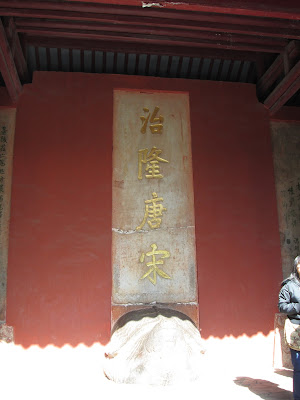With my visit to Sun Yat-sen's mausoleum at an end, I ventured to my next destination, 'The Ming Filial Tombs' (明孝陵), the tomb of the founding emperor of the Ming Dynasty ( 明代, 1368-1644): The Hongwu Emperor (洪武帝), or Zhu Yuanzhang (朱元璋, 1328-1398). As luck would have it, both Sun Yat-sen's mausoleum and the Zhu Yuanzhang's tomb were about a 15-minute walk apart from one another, both being buried on the mountainside of this vast mountain, called Purple Mountain (紫金山). The mountain itself is important in Chinese history, being the site of many important historical events going back thousands of years. For that reason, the mountain and the large forest surrounding it have been designated a national park, and are safe from any encroaching development.
Sights like this are a real rarity in China
Also uncharacteristic for China was the lack of vehicles around the area, though it wasn't until later that I realized only taxis, some buses, and special trolleys were allowed on these particular streets.
Unlike at Sun Yat-sen's mausoleum, somebody was checking the tickets, so I actually had to buy a ticket to enter
While being located almost right next to one another, the Ming Filial Tombs get nowhere near the same tourist traffic that Sun Yat-sen's mausoleum does. This is not surprising given Sun Yat-sen's importance to modern China; however, Zhu Yuanzhang was just as important in his time.
Zhu Yuanzhang could have very well been just another one of China's countless poor farming peasantry, born into grinding poverty as the youngest of a large family that could barely afford to feed itself. When Zhu was still a teenager, his family's land was devastated by a flood, followed shortly by a plague that killed everyone in Zhu's family except for himself and one of his brothers. Zhu became a Buddhist monk, but was forced to leave the monastery after the monks could not feed him.
Zhu's might have ended up as nothing more than a poor, nameless beggar if it weren't for the unusual times he lived in, since Zhu's adulthood happened to correspond with a series of rebellions against the Mongol-ruled Yuan Dynasty (元代, 1279-1368).
The characters read "Emperor Hongwu was a greater ruler than either Emperor Taizong of the Tang Dynasty (唐代, 618-907) or Emperor Taizu of the Song Dynasty (宋代, 907-1279)." These words were inscribed - rather ironically, I think - by Emperor Kangxi of the Qing Dynasty (清代, 1644-1912), which succeeded in toppling the Ming.
The Yuan Dynasty had dealt with many rebellions over its history, but the combination of constant court-infighting, inept local governments, and the sheer number and scale of the rebellions, led to the quick collapse of the Yuan. Zhu joined one of these local rebellions, and quickly managed to become one of the heads of a large alliance of rebels, united solely by their goal to crush the Yuan.
Over the course of the next two decades filled with shifting alliances, battles against other rebellious groups, and nearly constant warfare against the Yuan, Zhu succeeded in not only defeating and absorbing all of the other anti-Yuan rebellions under his command, but also in destroying the Yuan themselves, forcing what was left to retreat to Mongolia proper by 1368.
As emperor, comfortably ruling from his base in Nanjing, Zhu stripped away many longstanding court ceremonies, wanting his meetings to be as short and to the point as possible. He also made great effort to purge China's enormous bureaucracy of corruption - almost always through large-scale massacre and torture. Zhu went so far as to personally draft laws that would be easily comprehensible and could not be taken advantage of by any nefarious bureaucrats.
When I was taking this picture, a little boy walking with his parents nearby pointed at me and blurted out in Chinese "A foreigner! A foreigner!" (外国人!外国人!), so I pointed him and - imitating his surprise - yelled back in Chinese"A Chinese! A Chinese!" (中国人!中国人!), which caused the parents to burst out laughing and the little boy gave me a dumbfounded look.
The characters behind me read "Filial Tomb"
Zhu - probably remembering his horrible, poverty-stricken childhood in the countryside - also implemented a large scale program of land redistribution aimed at giving the peasantry much more usable and fairly-proportioned land.
The characters read "The grave of Emperor Hongwu of the Ming Dynasty", though it uses his 'temple name,' Ming Taizu (明太祖).
While Zhu Yuanzhang may not have had the same impact on modern China as Sun Yat-sen, I think it is appropriate to say that Zhu had just as much of an impact - if not much more - on the China of almost 700 years ago as Sun Yat-sen had on China 100 years ago.
Once I left the main area of the tomb, I realized that I'd entered the complex on the opposite side of where you were supposed to, as I found myself facing the back of the Lingxing Gate (棂星门), the traditional entrance to the tomb.
Lingxing Gate, in turn, connected to Celestial Statue Pathway (翁仲路神道), which was lined with statues of both generals and high-ranking civil officials overlooking visitors to the tomb, and demonstrating their subservience to the Hongwu Emperor.
My exploration of the Ming Filial Tombs was complete, but my time in Nanjing was far from over, which I will cover in my next blog post!
Until next time!







































No comments:
Post a Comment